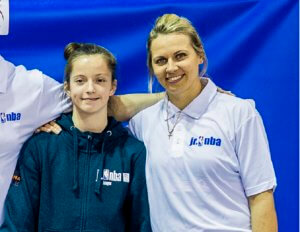Riga, Latvia.
It was only very fitting that the European Girls Basketball League (EGBL) U13 Superfinals that took place May 3rd-6th in Riga at “Daugava Sporta Nams” venue, home of the legendary TTT Riga, was actually dedicated to the U13 category as it was at the exact same age of 13 and in this very gym that one of women’s basketball all-time legend and Hall of Famer Uljana Semenova started her illustrous career. It is actually surprising that her name is not officially attached to the facility as she, not even mentioning both her domestic and USSR NT records, propelled her club to an incredible, and still running, overall record of 18 European Cup for Women’s Champions Clubs titles (former name of Euroleague Women), 15 of which she directly contributed to (including 12 consecutive ones between 1964 and 1975!). Fitting place indeed to perpatuate the tradition of women’s basketball. Whether the young girls who competed on this wooden floor just ten days ago were aware of these facts or not doesn’t really matter. The spirits of women’s basketball were. As a testimony of the importance of the venue, the Latvian Basketball Federation decided to locate in the main hall and in the staircases leading to the court the unofficial museum of Latvian basketball allowing athletes and fans to discover/appreciate/learn about Latvia’s past and present achievements and successes .
U13 EYBL Finals in Riga 🇱🇻 for @BlueStarMedia1 🙌 with @pierrepiotr_
Next generation and will be seeing some of these players soon at #FIBAU16Europe and maybe #FIBAU17 in 2022
Also got an U19 Finals too this weekend 🏀♀️🏀 pic.twitter.com/eFxoLt8m2r
— @Basketmedia365 🏀♀️🏀Paul Nilsen 🌈 (@basketmedia365) May 4, 2018
Day 2 for @BlueStarMedia1 in Riga at U13 Finals. Tournament taking place in such a wonderful historic basketball building – so much @basketbols and @fiba history 🇱🇻WOW! pic.twitter.com/0CcuVPPlmi
— @Basketmedia365 🏀♀️🏀Paul Nilsen 🌈 (@basketmedia365) May 5, 2018
From the initial 16 teams representing 8 countries (Estonia, Finland, Czech Republic, Poland, Latvia, Russia, Ukraine and Belarus) taking part in this competition, 8 teams qualified for this Superfinals thanks to their ranking at the end of the regular season : Ridzene and Jugla (Latvia), Pomeranie (Poland), Prinemanie (Belarus), School 221 (Russia), Honka (Finland), Audentes (Estonia) and Bagira (Ukraine) and all hoped to claim the title. The EGBL was founded in the year 2000 by a small number of motivated and ambitious coaches from the Baltic States, Poland, Belarus and Russia on their own initiative. Their goal was to provide their players with the possibility of experiencing international competition as early as possible in order to optimize their development. The EGBL was created just 2 years after the equivalent Boys section, called EYBL (European Youth Basketball League), which celebrates this year its 20th year of existence. What started with a limited number of countries has since evolved into a 30 countries-strong structure with competition covering 5 age categories from U12 to U19 for the girls and U14 to U19 for the boys. One can only praise and support the initiative to strenghten the level of action offered through international competition, as well as the quality of organization they are showing/managing. Not least being a very practical and efficient website or the FibaLiveStats provided for each game, even U12!
Back to the tournament now.
So the 8 qualified teams present in Riga were divided in 2 groups, A & B. Each team played 3 group games. The 2 best teams of each group qualified for the semi-finals, the remaining 2 played classification games to determine the 5 to 8 spots. It could have been great but in my opinion this “Final 8” format wasn’t the most adequate given that out of the 8 teams three (Honka, Jugla, Bagira) were clearly not able, despite all their efforts, to compete for a spot in the semi-finals losing by big margins against the 3 stronger teams (Prinemanie, Ridzene, Audentes). Pomeranie (POL) looked like a good candidate to be the 4th semi-finalist but they somehow unexpectedly suffered upsets in their group games which allowed the, to me, unimpressive Russian side School 221, who apparently was missing their key player to knee injury making them look a bit weak, to grab the last semi-final spot. I believe that a Final 4 format would have done more service to the competition. That is because during the first 2 days of competition each team had to play twice a day, with the second game of Day 2 also happening to be the semi-finals. Players looked tired during those second games and it did have an imapct on their efficiency unfortunately. It was the case for the Polish side on Day 1 against Audentes (EST) which cost them, not only this of course but it is part of the frame, the semi-final spot, and also for the latter on Day 2 during their semi-final against Prinemanie (BLR) where they managed to score their 1st point only halfway into Q2, finishing scoreless in Q1 (21-0…). Furthermore it kind of prevaricated the tournament’s individual statistics as some coaches opted to rest their key players during these easier match-ups, while other players saw their inflate thanks to post big numbers posted against wekaer teams. So the individual statistics numbers are a bit irrelevant to fully stress any point here.
These precisions being said, the title game did see the two best teams of the competition face each other, with the clear favorites, Prinemanie (BLR) walking home with the trophy after defeating the home side Ridzene (LAT). The Belarussian side looked like the most mature and well organized unit with players able to somehow control both their bodies and the rythym of plays. Their spacing, movement off the ball and passing was ahead of the other teams. I don’t know if it is a shell printing in the program but 2 of their main players, including my co-MVP (Yana Zaharevich) are actually announced as 2004-born and not 2005 as supposed. Adding to my questionning is the fact that none of them played with the team during regular season and only joined the roster in March. But if it really is the case, this would, given the difference one single year makes at that age, explain the impression of control displayed. It would then leave me with the big interrogation as of how can 2 beyond-age-limit players compete during official games!…
Overall, the quality of action was quite approximative with a, I would suppose, understandable (?) excessive number of turnovers, mistakes, poor decisions, bad shots and lack of spacing for this age category. I am furthermore a bit alarmed by the too significant amount of travels and double-dribbles, whether they were called or not, committed by the big majority of players. On that matter, I’m equally alarmed by the laxism of the referees. It is not doing the players a favor not sanctionning the most basic fundamentals needed in basketball when not executed properly. As for the quality of the players individually, one can only try to sense what the players could develop into in the coming months/years, much can happen in both ways.
Given the very young age of the players, not many, if any, presented a complete and solid skills set, much work is still needed for all of them including the ones who stood out. Talking of which one of these players is Ridzene’s G/SG Raina Tomasicka (2005, 5’4), my other co-MVP of the tournament, who is already building a resume for herself: it is worth informing that she joined her team only on the second day of action as she was away attending the European “Jr. NBA World Championship” Camp in Rogla, Slovenia (April 30th- May 4th) after the Latvian Federation chose her as the only Latvian representant for both boys and girls to attend and try to make the cut to be among the 10 best Europeans who will participate in the 1st Jr. NBA World Championship (a new U14 program) taking place in August this summer in Orlando, Florida . The potential she displayed already last season in the 2016-2017 Latvian “NBA Jr. League” motivated the Federation’s decision. She certainly has a lot of potential. Her dribbling skills, feel for the game, instinctive shot, good hands/touch are unquestionnable. But she struggles to play collectively and forces/overdoes things way too much for now, showing even tough character sometimes. This also was the comments the coaches in Slovenia after the camp made about her. Her passion is huge obviously as she played the same day she returned from the camp, furthermore as soon as the medal/awards ceremony was over she was the only girl back on the court shooting the ball!

(Raina Tomasicka in Slovenia during the Jr. NBA camp alongside Latvian legend and ELW/WNBA champion Anete Jekabsone-Zogota)
Our player of the day from the U13 EGBL SuperFinals in Riga.
Yes, 🇱🇻 has got talent! Step forward… or maybe that is more like dribble and lean back… Rena Tomasicka
Here are 3 of her plays as she makes it look so smooth at just 13 years old 🔥🔥🔥
📽️@basketmedia365 pic.twitter.com/p1rMFuX2aZ
— BlueStar Media (@BlueStarMedia1) May 5, 2018
Ridzene (Latvia) was not just a one-player team and interesting things could come Latvia’s way from the likes of Auguste Felicita Romanovska (2005, PF/C, 5’8) a hard-working, strong frame, unfancy quality big. Kira Minckovska (2005, SF/PF, 5’7) an impressively strong and tireless player who is 500% focused on her duties/assignements on court showing great concentration and abnegation, or Patricija Vancane (2005, C, 5’9) a potentially interesting center who is not overly tonic but nevertheless quite mobile and who seems to assimilate post-positionning well.
Prinemanie (Belarus) as already specified had a high quality player in the shape of my co-MVP Yana Zaharevich (2004?, C, 5’11) whose strong body control allow to play very efficiently. Good anticipation, nice dissuasion in defense, smart moves and soft touch in offense, she does run rather slowly but nothing that further athletic work couldn’t improve.
🇧🇾Yana Zaharevich was my MVP by some distance at U13 EYBL Finals in Riga.
Blocked shots for fun, great anticipation and hands despite not being athletic and made offense so simple and effective.
Loved her and did not even get in ATT 👉https://t.co/JtNWx4dZFL pic.twitter.com/0brMUUKcEi
— @Basketmedia365 🏀♀️🏀Paul Nilsen 🌈 (@basketmedia365) May 6, 2018
Yauhenia Bernatskaya (2005, G, 5’3) showed signs of potential as a backcourt option. She is capable of acrobatic finishes off the drive, is part of the Belarussian players who stood out with body control and balance allowing her to take good care of the ball and not turning it over excessively. She needs to work on her perimiter shot (0/15 FG3) obviously! Elizaveta Shyshliuk (2005, G/SF, 5’7) also has a mature body control, has good size for a backcourt player, defends strong, has some range though her shooting form is odd as she shoots with the right hand the mid-range jumpers and FT but the left hand the 3FG… Finally the other mysterious 2004-born player who showed good aptitudes is a very athletic PF whose physical qualities are promising and allow her to harvest a considerable amount of rebounds : Alisia Slizh (2004?, PF, 5’7).
Audentes (Estonia) could count on the quality of center Keandra Koorits (2005, C/PF, 5’9) whose smart footwork, patience on court plus a nice soft touch could lead her further in the future if she works on her physicality and flexibility. Anna-Liis Vannamik (2005, PF/C, 5’9) was a nice complement to Koorits in the frontcourt, both working well together. Rather unfancy, she looks like a reliable smart player overall. Guard Jenny Roos (2005, G, 5’4) is somebody i will keep an eye on in the coming events as well.
Impressed with Keandra Koorits of SC Audentes of Tallin. Some potential for sure. Would be nice for EST to get more talents coming through. @BlueStarMedia1 pic.twitter.com/SbpI1OZRyQ
— @Basketmedia365 🏀♀️🏀Paul Nilsen 🌈 (@basketmedia365) May 5, 2018
Pomeranie (Poland) also had a few players worth keeping an eye on, particularly PG/G Weronika Kassin (2005, PG/G, 5’4) who was among the players with better body control and overall aptitude for the game, displaying strong dribbling skills and above-average athleticism, maybe focusing on showing less attitude/nerves would help develop into a more interesting player. Marita Gula (2005, SF, 5’7) is quite versatile and is already a good athlete.
Final 4 results
Semi-Finals
Audentes (EST) 19 – Prinemanie (BLR) 59
Ridzene (LAT) 41 – School 221 (RUS) 37
Final
Ridzene (LAT) 34 – Prinemanie (BLR) 42
3rd place
School 221 (RUS) 41 – Audentes (EST) 37
Final standings
- Prinemanie
- Ridzene
- School 221
- Audentes
- Bagira
- Pomeranie
- Jugla
- Tapiolan Honka
My co-MVP’s
- Raina Tomasicka (Ridzene, Latvia)
- Yana Zaharevich (Prinemanie, Belarus)
My All-Tournament Five
- Raina Tomasicka (Ridzene, Latvia)
- Weronika Kassin (Pomeranie, Poland)
- Auguste Felicita Romanovska (Ridzene, Latvia)
- Keandra Koorits (Audentes, Estonia)
- Yana Zaharevich (Prinemanie, Belarus)
My All-Tournament Second Five
- Yauhenia Bernatskaya (Prinemanie, Belarus)
- Elizaveta Shyshliuk (Prinemanie, Belarus)
- Anna-Liis Vannamik (Audentes, Estonia)
- Kira Minckovska (Ridzene, Latvia)
- Patricia Vancane (Ridzene, Latvia)
Born to Polish PE teachers/coaches parents, involvement with sport and basketball was never a question. Eastern attention to fundamentals, athleticism, discipline and hard work eventually met Western standards through his development in the French system. Now a former player with a passion for the women’s game going back for more than 25 years, he uses his knowledge to bring insights and perspective on women's basketball internationally - with a strong emphasis on Europe and player development.





